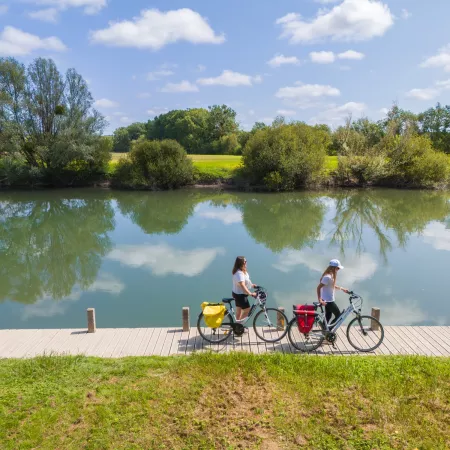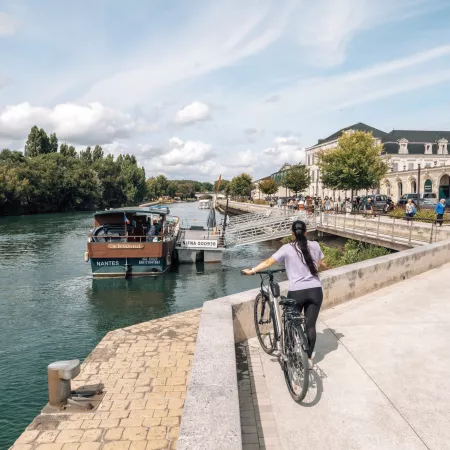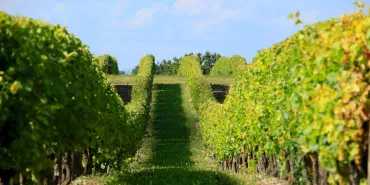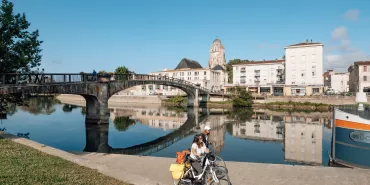The Charente Valley between Rochefort and Angoulême
You’ll be guided by the course of the Charente River for much of the length of La Flow Vélo®. The main thread for a large part of the cycle route, you follow the Charente’s course from the city Angoulême to the Charente Estuary, passing through the towns of Cognac, Saintes and Rochefort, each awarded accreditation as a Ville d'Art et d'Histoire for its cultural riches.
In the wake of river traders of the past
The Charente River becomes navigable from Angoulême. This city is where La Flow Vélo cycle route begins its long flirtation with the great river that 16th-century French king François I described as the prettiest brook in his kingdom! While beside the Charente in Angoulême, do visit the former Le Nil paper mills, the buildings right on the water now home to an interpretation centre dedicated to the paper-making industry so closely associated with the Charente River.
Following the banks of the Charente, do visit the village of Saint-Simon, between the towns of Angoulême and Jarnac. In centuries past, gabarriers – boatmen who transported merchandise on traditional river boats called gabarres – lived here, hence the Maison des Gabarriers, which preserves the memory of the history of river boats and river traders along the Charente.
In centuries past, gabarres were very widely used for transporting merchandise along the Charente. These boats had flat bottoms, enabling them to navigate even when the river level was low, while still carrying a full load. Some were used to transport cannons made at Ruelle-sur-Touvre, ferried downriver to defend the famed Charentais coastal forts. Heading back upstream, salt and produce from the colonies, such as spices, sugar and coffee, were loaded on the boats. Today, the replicas of 19th-century gabarres are used for lovely, relaxing river-boat trips, either from Saint-Simon, aboard La Renaissance, or from Saintes.
Another boat for a cruise: Based in Saintes, Le Bernard Palissy III provides a first on the Charente, a trip on a solar electric boat… which you can board to make the most of a cruise along the river between Saintes and Saint-Savinien.
Picturesque villages in the Saintonge Romane area
Between Saintes and Tonnay-Charente, the Charente Valley is dotted with picturesque villages that long thrived from quarrying the local limestone rock. A visit to La Pierre de Crazannes Nature Centre, with its sculptures, Les Lapidiales de Port-d’Envaux, also with a sculpture trail, or the Château de Taillebourg will greatly appeal to fans of art and architecture, as well as those who love the countryside.
Designated a Petite Cité de Caractère for its historic character, the village of Saint-Savinien is a great place for a bucolic outing along its well-flowered banks. Its waterside, stone-built houses with their orange roof tiles look like they’re dipping their feet in the river; they recall how river trade once flourished in these parts. Take your time wandering around the village, from Quai des Fleurs to the lanes of the historic quarter, enjoying this picture-postcard place.
From Tonnay-Charente to the Charente Estuary
A stone’s throw from the port of Rochefort, the older port of Tonnay-Charente, backing onto a cliff on the north bank of the river, is easy to spot thanks to its magnificent suspension bridge, reaching 23m in height above the Charente. For centuries, the port was a lively trading post. You can imagine the old, flat-bottomed gabarres carrying Angoulême paper, wines and spirits from the Saintonge area, or the pale limestone from the quarries of Saint-Savinien-sur-Charente.
You may already scent the sea air. The landscapes shift in a magical way as you arrive at the start of the Charente Estuary… which you can also explore on a cruise from Rochefort, renowned as the home port of Lafayette’s famed frigate, L'Hermione.
The Charente’s broad estuary became heavily fortified from the time of Louis XIV, France’s Sun King. The port of Rochefort, developed from the late-17th century onwards for the royal fleet, was where many vessels were built and armed for the French Navy before being sent out into the wide bay beyond the estuary. The Fort de la Pointe and Fort Lupin, on either side of the Charente Estuary, provide excellent examples of the whole system of defences designed by Louis XIV’s great military engineer, Vauban.
As you get closer to the Atlantic, the sea air becomes more tangible. Reaching the resort of Fouras, you’ll find yourself within touching distance of the ocean. From here, you can get a boat for Aix Island, the most westerly port of call on this long-distance cycling adventure.




